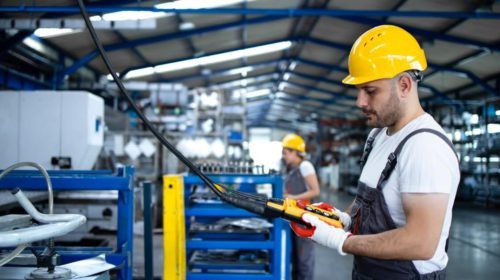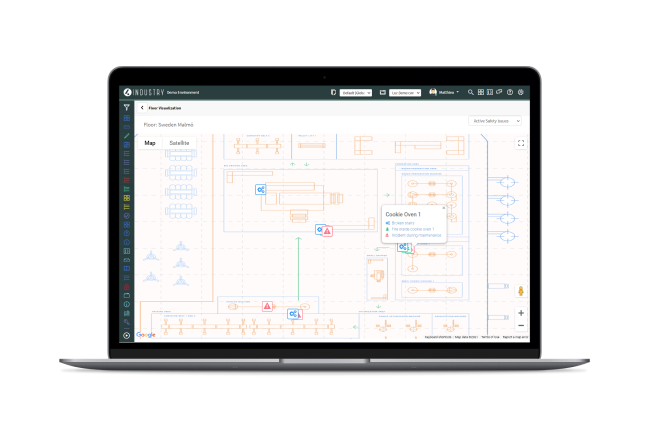
4 Common Questions about Safety in Manufacturing
Safety in manufacturing is all-important. Find which safety measures you can undertake in your factory and how digitalization can bring about a safer shop floor.

In 2018, the manufacturing industry accounted for 19% of all non-fatal and 15% of all fatal occupational accidents. Although that number is certainly staggering, it is not at all surprising: in an environment with heavy objects, fast-moving machinery, and caustic or flammable chemicals, an accident always lurks around the corner. This prevalence of accidents leaves many managers and safety officers wondering what additional measures they can implement to increase safety on the shop floor.
This article provides answers to the most common questions relating to safety in manufacturing. Apart from listing the most common safety measures and discussing how you can bring about a safer shop floor, attention will be paid to how digitalization can help produce an optimal safety culture by reducing incidents.
1. Why is safety in manufacturing important?

An unsafe shop floor can give workers (permanent) injuries and health issues, and even lead to loss of life. Apart from these tragic, all-important human consequences of unsafe manufacturing, there is a monetary cost to consider. Liberty Mutual estimates that in the US alone, the top 5 causes of non-fatal occupational incidents in manufacturing amount to over 6 billion dollars in costs. These top causes are mainly related to the improper handling of objects, equipment, and machines. As we’ll see, there are several safety measures manufacturers can implement to improve in those areas. If incidents become a pattern in your manufacturing facility, this has the serious side-effect of causing hiring problems. If your factory has a reputation of being unsafe, potential employees will be discouraged from working there.
2. How can I bring about a safer shop floor?

First of all, you should have a clear picture of what is happening on the shop floor. When an incident occurs, operators should take time to report it to safety officers. It is also crucial that you have perspective on unsafe situations and near misses. As these aren’t incidents in themselves, they are in essence harder to register – but as they do underly incidents, you should be aware of them so they can be avoided in the future. A solution is to have workers report unsafe situations and near misses just like they report incidents. We furthermore recommend that all members of management do (regular) safety audits on the shop floor.

Solely registering unsafe situations and incidents is, however, not sufficient; workers have to receive feedback on the reports they submit. It is important that safety managers always quickly follow up on reports. Even if they don’t plan on acting on a report at a particular moment, they should communicate to workers that the report has been received and will be followed up on in the future.

After you have sufficient insight on which safety hazards exist on the shop floor, you can start defining safety measures. It is important to revise and reassess these regularly so they accord with what’s happening in the field. To ensure this happens, operators should be stimulated to continue filing safety reports.
3. What are the most common safety measures in manufacturing?

Giving workers safety training and personal protective equipment (PPE) are two of the most common safety measures in manufacturing. Although these have their obvious benefits, there are safety measures of greater importance. It is paramount to ensure that workers don’t come into contact with dangerous machines. This can be done by shielding off dangerous machine parts with plexiglass and installing motion sensors that shut down machines when a worker approaches them. These measures are mostly applicable to older machines: new machines are safer, as they have these preventive safety measures inbuilt.
Having safe machines is however not enough to ensure that a shop floor is safe. We at 4Industry believe the future of safety in manufacturing lies in preventive measures that are implemented through digitalization. This subject will be fleshed out in the next paragraphs.
4. How can digitalization help me increase safety?

Digitalizing your manufacturing operation can significantly increase safety on the shop floor. 4Industry’s mobile-enabled connected worker platform allows workers to, among other things, report incidents and post pictures of (potential) hazards and faulty machines. The great thing about digital safety measures is that they are quick and entirely paperless: workers don’t have to remove themselves from the shop floor to fill out a safety form, but can instantly do it on the spot. All safety-related data is stored on a central database and visualized in streamlined, easy-to-understand dashboards. This allows safety officers to have better visibility on what kinds of incidents occur on the shop floor, making the process of implementing safety measures much easier. 4Industry furthermore supplies digital forms for risk assessment, which allow safety managers to click on machines and see which hazards are still present.
An optimal safety culture, of course, necessitates a continued focus on the subject. To ensure management’s continued engagement, the importance of safety should be a topic in daily stakeholder meetings. Gamification is a great method of maintaining workers’ attention on safety practices. A connected worker platform can send workers surveys or lists of questions about safety. Workers that report the most safety incidents in a particular month can be rewarded with small prizes, like restaurant coupons. Through gamification safety can, in short, be fun.
Related Articles



